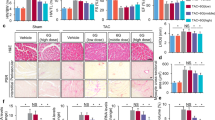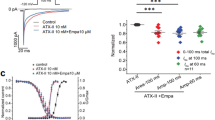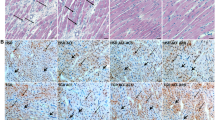Abstract
The aim of this study was to investigate whether atorvastatin inhibits epidermal growth factor receptor (EGFR) activation in cardiomyocytes in vitro and slows the progression of cardiac remodeling induced by pressure overload in mice. Either atorvastatin (5 mg/kg/day) or vehicle was orally administered to male C57BL/6J mice with transverse aortic constriction (TAC). Physiological parameters were obtained by echocardiography or left ventricular (LV) catheterization, and morphological and molecular parameters of the heart were also examined. Furthermore, cultured neonatal rat cardiomyocytes were studied to clarify the underlying mechanisms. Four weeks after TAC, atorvastatin reduced the heart/body weight and lung/body weight ratios (8.69±0.38 to 6.45±0.31 mg/g (p<0.001) and 10.89±0.68 to 6.61±0.39 mg/g (p<0.01) in TAC mice with and without atorvastatin, respectively). Decrease of LV end-diastolic pressure and the time constant of relaxation, increased fractional shortening, downregulation of a disintegrin and metalloproteinase (ADAM)12, ADAM17 and heparin-binding epidermal growth factor genes, and reduction of the activity of EGFR and extracellular signal–regulated kinase (ERK) were observed in the atorvastatin group. Phenylephrine-induced protein synthesis, phosphorylation of EGFR, and activation of ERK in neonatal rat cardiomyocytes were all inhibited by atorvastatin. These findings indicated that atorvastatin ameliorates cardiac remodeling in mice with pressure overload, and its actions are associated with inhibition of the EGFR signaling pathway.
Similar content being viewed by others
Article PDF
References
Yan AT, Yan RT, Liu PP : Narrative review: pharmacotherapy for chronic heart failure: evidence from recent clinical trials. Ann Intern Med 2005; 142: 132–145.
Fukuta H, Sane DC, Brucks S, Little WC : Statin therapy may be associated with lower mortality in patients with diastolic heart failure: a preliminary report. Circulation 2005; 112: 357–363.
Horwich TB, MacLellan WR, Fonarow GC : Statin therapy is associated with improved survival in ischemic and non-ischemic heart failure. J Am Coll Cardiol 2004; 43: 642–648.
Sola S, Mir MQ, Lerakis S, Tandon N, Khan BV : Atorvastatin improves left ventricular systolic function and serum markers of inflammation in nonischemic heart failure. J Am Coll Cardiol 2006; 47: 332–337.
Node K, Fujita M, Kitakaze M, Hori M, Liao JK : Short-term statin therapy improves cardiac function and symptoms in patients with idiopathic dilated cardiomyopathy. Circulation 2003; 108: 839–843.
Kjekshus J, Dunselman P, Blideskog M, et al: A statin in the treatment of heart failure? Controlled rosuvastatin multinational study in heart failure (CORONA): study design and baseline characteristics. Eur J Heart Fail 2005; 7: 1059–1069.
Tavazzi L, Tognoni G, Franzosi MG, et al: Rationale and design of the GISSI heart failure trial: a large trial to assess the effects of n-3 polyunsaturated fatty acids and rosuvastatin in symptomatic congestive heart failure. Eur J Heart Fail 2004; 6: 635–641.
Asakura M, Kitakaze M, Takashima S, et al: Cardiac hypertrophy is inhibited by antagonism of ADAM12 processing of HB-EGF: metalloproteinase inhibitors as a new therapy. Nat Med 2002; 8: 35–40.
Liao Y, Asakura M, Takashima S, et al: Benidipine, a long-acting calcium channel blocker, inhibits cardiac remodeling in pressure-overloaded mice. Cardiovasc Res 2005; 65: 879–888.
Liao Y, Ishikura F, Beppu S, et al: Echocardiographic assessment of LV hypertrophy and function in aortic-banded mice: necropsy validation. Am J Physiol Heart Circ Physiol 2002; 282: H1703–H1708.
Youssef S, Stuve O, Patarroyo JC, et al: The HMG-CoA reductase inhibitor, atorvastatin, promotes a Th2 bias and reverses paralysis in central nervous system autoimmune disease. Nature 2002; 420: 78–84.
Teichholz LE, Kreulen T, Herman MV, Gorlin R : Problems in echocardiographic volume determinations: echocardiographic-angiographic correlations in the presence of absence of asynergy. Am J Cardiol 1976; 37: 7–11.
Iwamoto R, Yamazaki S, Asakura M, et al: Heparin-binding EGF-like growth factor and ErbB signaling is essential for heart function. Proc Natl Acad Sci U S A 2003; 100: 3221–3226.
Privratsky JR, Wold LE, Sowers JR, Quinn MT, Ren J : AT1 blockade prevents glucose-induced cardiac dysfunction in ventricular myocytes: role of the AT1 receptor and NADPH oxidase. Hypertension 2003; 42: 206–212.
Asanuma H, Kitakaze M, Node K, et al: Benidipine, a long-acting Ca channel blocker, limits infarct size via bradykinin- and NO-dependent mechanisms in canine hearts. Cardiovasc Drugs Ther 2001; 15: 225–231.
Kitakaze M, Node K, Minamino T, Asanuma H, Kuzuya T, Hori M : A Ca channel blocker, benidipine, increases coronary blood flow and attenuates the severity of myocardial ischemia via NO-dependent mechanisms in dogs. J Am Coll Cardiol 1999; 33: 242–249.
Tatsumi T, Akashi K, Keira N, et al: Cytokine-induced nitric oxide inhibits mitochondrial energy production and induces myocardial dysfunction in endotoxin-treated rat hearts. J Mol Cell Cardiol 2004; 37: 775–784.
Liao Y, Takashima S, Asano Y, et al: Activation of adenosine A1 receptor attenuates cardiac hypertrophy and prevents heart failure in murine left ventricular pressure-overload model. Circ Res 2003; 93: 759–766.
Liao Y, Asakura M, Takashima S, et al: Celiprolol, a vasodilatory beta-blocker, inhibits pressure overload-induced cardiac hypertrophy and prevents the transition to heart failure via nitric oxide–dependent mechanisms in mice. Circulation 2004; 110: 692–699.
Lucchesi PA, Sabri A, Belmadani S, Matrougui K : Involvement of metalloproteinases 2/9 in epidermal growth factor receptor transactivation in pressure-induced myogenic tone in mouse mesenteric resistance arteries. Circulation 2004; 110: 3587–3593.
Suzuki M, Raab G, Moses MA, Fernandez CA, Klagsbrun M : Matrix metalloproteinase-3 releases active heparin-binding EGF-like growth factor by cleavage at a specific juxtamembrane site. J Biol Chem 1997; 272: 31730–31737.
Hinkle CL, Sunnarborg SW, Loiselle D, et al: Selective roles for tumor necrosis factor alpha–converting enzyme/ADAM17 in the shedding of the epidermal growth factor receptor ligand family: the juxtamembrane stalk determines cleavage efficiency. J Biol Chem 2004; 279: 24179–24188.
Ohtsu H, Dempsey PJ, Eguchi S : ADAMs as mediators of EGF receptor transactivation by G protein–coupled receptors. Am J Physiol Cell Physiol 2006; 291: C1–C10.
Sakata Y, Yamamoto K, Mano T, et al: Activation of matrix metalloproteinases precedes left ventricular remodeling in hypertensive heart failure rats: its inhibition as a primary effect of angiotensin-converting enzyme inhibitor. Circulation 2004; 109: 2143–2149.
Moshal KS, Tyagi N, Moss V, et al: Early induction of matrix metalloproteinase-9 transduces signaling in human heart end stage failure. J Cell Mol Med 2005; 9: 704–713.
Nicholls SJ, Cutri B, Worthley SG, et al: Impact of short-term administration of high-density lipoproteins and atorvastatin on atherosclerosis in rabbits. Arterioscler Thromb Vasc Biol 2005; 25: 2416–2421.
Fukumoto Y, Libby P, Rabkin E, et al: Statins alter smooth muscle cell accumulation and collagen content in established atheroma of watanabe heritable hyperlipidemic rabbits. Circulation 2001; 103: 993–999.
Patel R, Nagueh SF, Tsybouleva N, et al: Simvastatin induces regression of cardiac hypertrophy and fibrosis and improves cardiac function in a transgenic rabbit model of human hypertrophic cardiomyopathy. Circulation 2001; 104: 317–324.
Takemoto M, Node K, Nakagami H, et al: Statins as antioxidant therapy for preventing cardiac myocyte hypertrophy. J Clin Invest 2001; 108: 1429–1437.
Thomas WG, Brandenburger Y, Autelitano DJ, Pham T, Qian H, Hannan RD : Adenoviral-directed expression of the type 1A angiotensin receptor promotes cardiomyocyte hypertrophy via transactivation of the epidermal growth factor receptor. Circ Res 2002; 90: 135–142.
Kagiyama S, Eguchi S, Frank GD, Inagami T, Zhang YC, Phillips MI : Angiotensin II–induced cardiac hypertrophy and hypertension are attenuated by epidermal growth factor receptor antisense. Circulation 2002; 106: 909–912.
Zhang H, Chalothorn D, Jackson LF, Lee DC, Faber JE : Transactivation of epidermal growth factor receptor mediates catecholamine-induced growth of vascular smooth muscle. Circ Res 2004; 95: 989–997.
Zhai P, Galeotti J, Liu J, et al: An angiotensin II type 1 receptor mutant lacking epidermal growth factor receptor transactivation does not induce angiotensin II–mediated cardiac hypertrophy. Circ Res 2006; 99: 528–536.
Nadruz W Jr, Lagosta VJ, Moreno H Jr, Coelho OR, Franchini KG : Simvastatin prevents load-induced protein tyrosine nitration in overloaded hearts. Hypertension 2004; 43: 1060–1066.
Miura S, Matsuo Y, Saku K : Simvastatin suppresses coronary artery endothelial tube formation by disrupting Ras/Raf/ERK signaling. Atherosclerosis 2004; 175: 235–243.
Morikawa-Futamatsu K, Adachi S, Maejima Y, et al: HMG-CoA reductase inhibitor fluvastatin prevents angiotensin II–induced cardiac hypertrophy via Rho kinase and inhibition of cyclin D1. Life Sci 2006; 79: 1380–1390.
Landmesser U, Engberding N, Bahlmann FH, et al: Statin-induced improvement of endothelial progenitor cell mobilization, myocardial neovascularization, left ventricular function, and survival after experimental myocardial infarction requires endothelial nitric oxide synthase. Circulation 2004; 110: 1933–1939.
Rosenson RS, Tangney CC, Casey LC : Inhibition of proinflammatory cytokine production by pravastatin. Lancet 1999; 353: 983–984.
Pliquett RU, Cornish KG, Peuler JD, Zucker IH : Simvastatin normalizes autonomic neural control in experimental heart failure. Circulation 2003; 107: 2493–2498.
Author information
Authors and Affiliations
Corresponding author
Rights and permissions
About this article
Cite this article
Liao, Y., Zhao, H., Ogai, A. et al. Atorvastatin Slows the Progression of Cardiac Remodeling in Mice with Pressure Overload and Inhibits Epidermal Growth Factor Receptor Activation. Hypertens Res 31, 335–344 (2008). https://doi.org/10.1291/hypres.31.335
Received:
Accepted:
Issue date:
DOI: https://doi.org/10.1291/hypres.31.335
Keywords
This article is cited by
-
Update on statin-mediated anti-inflammatory activities in atherosclerosis
Seminars in Immunopathology (2009)



